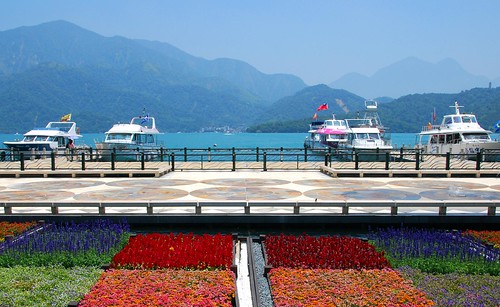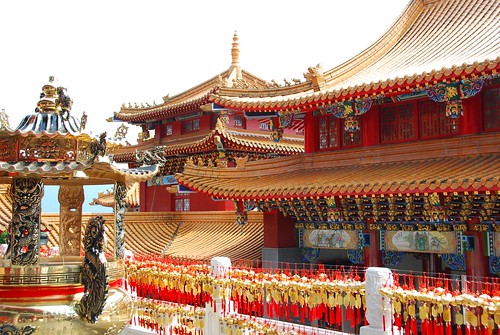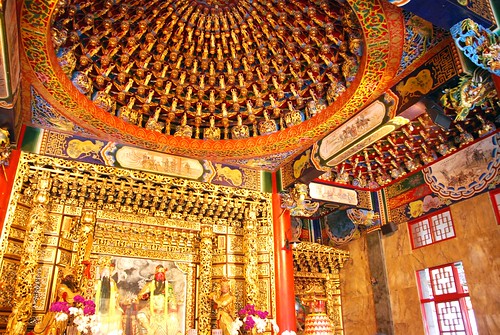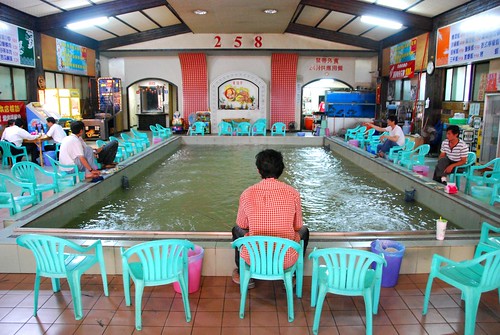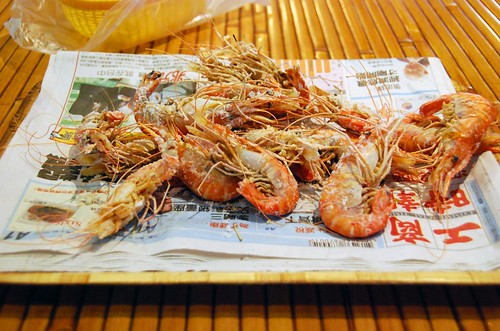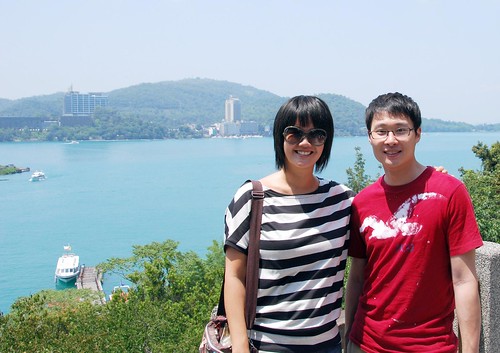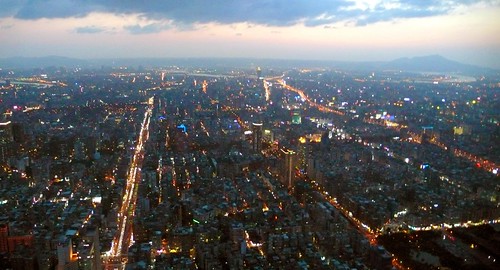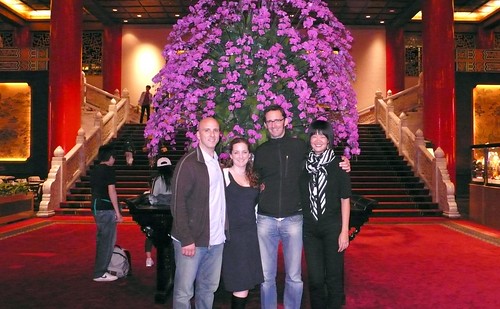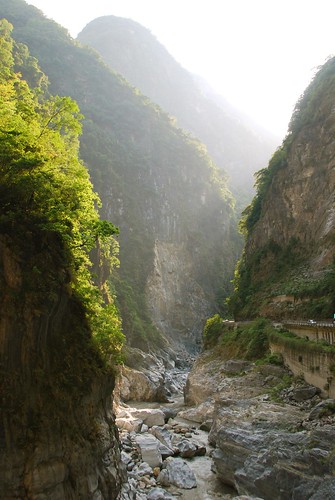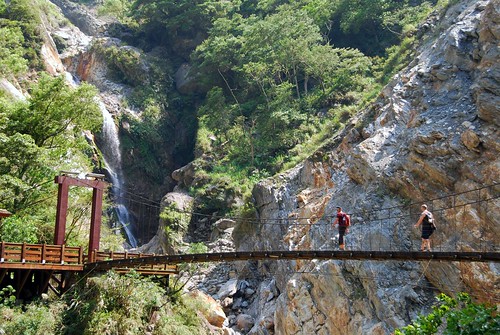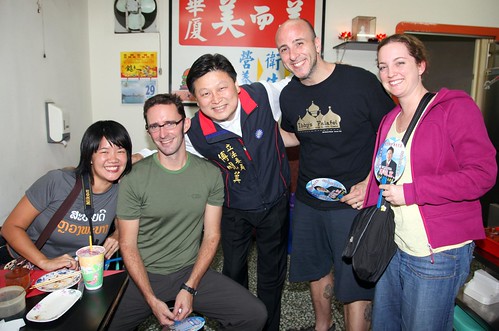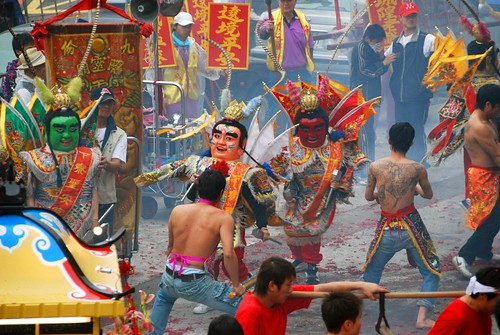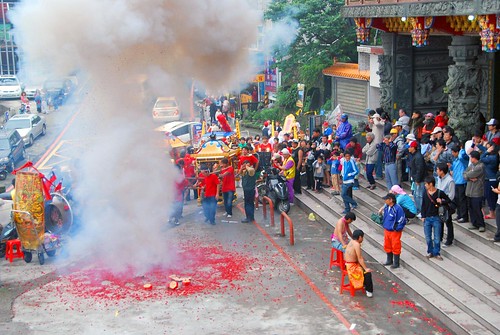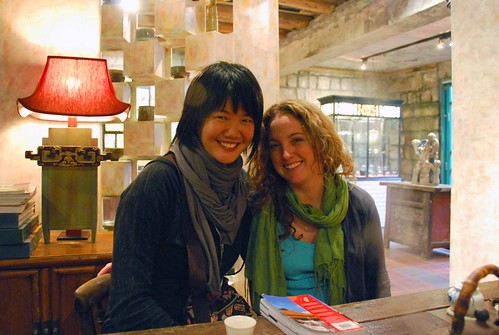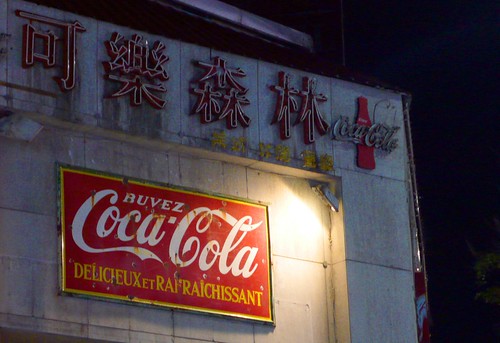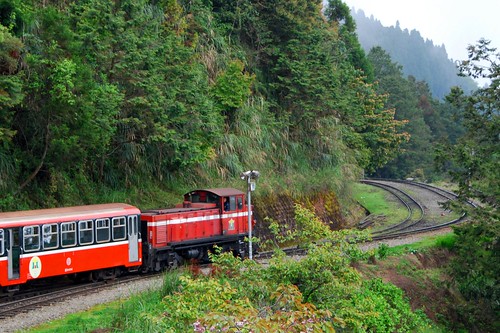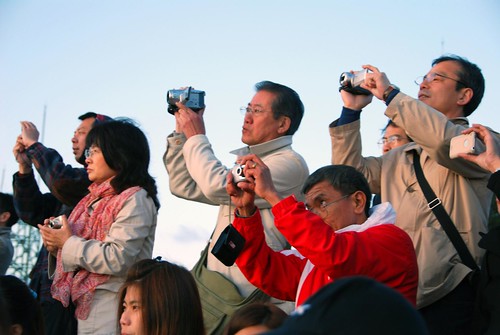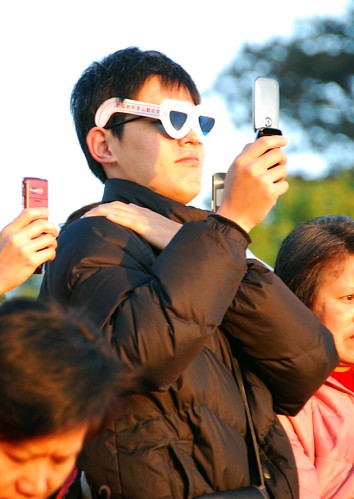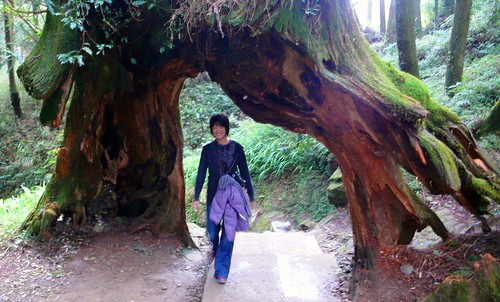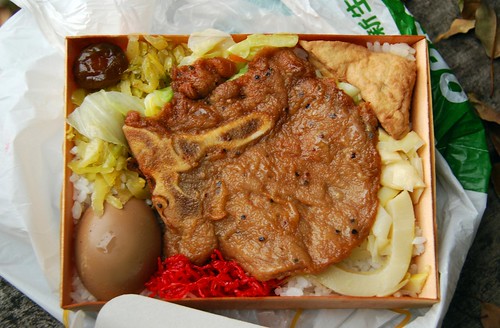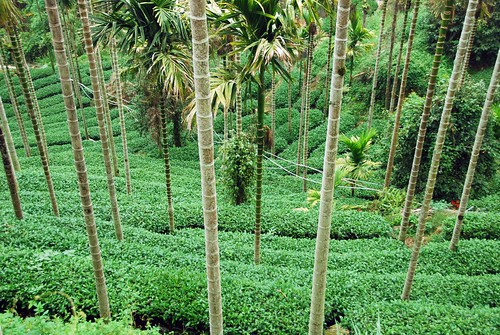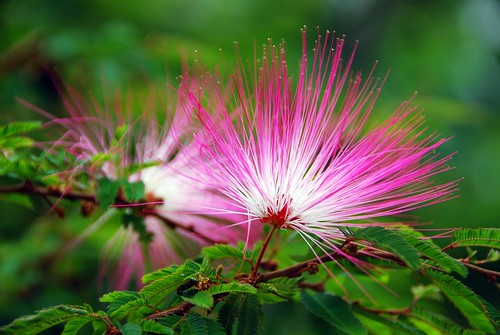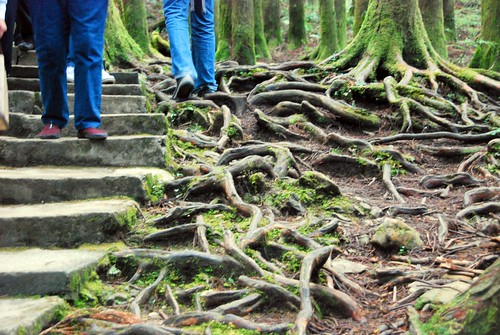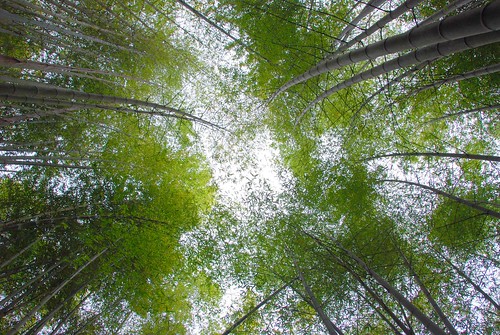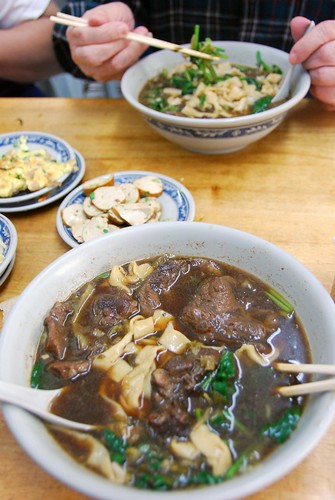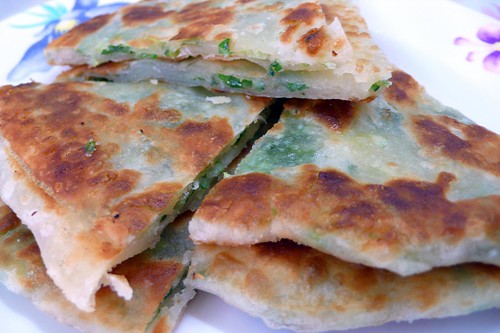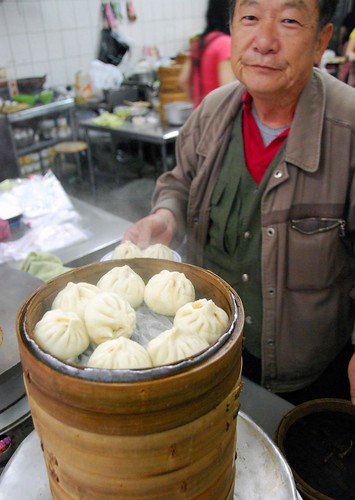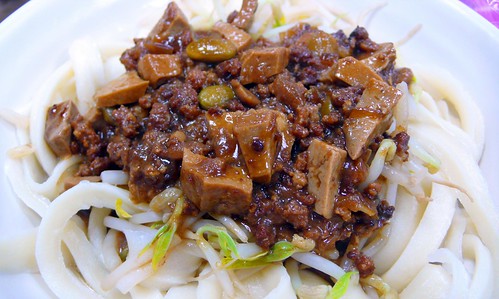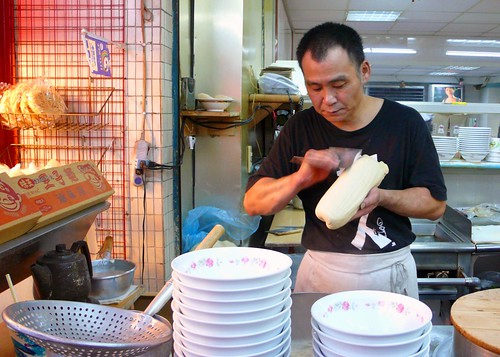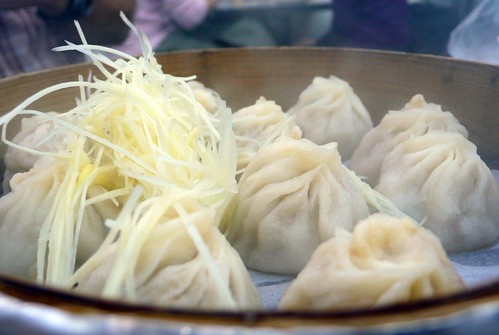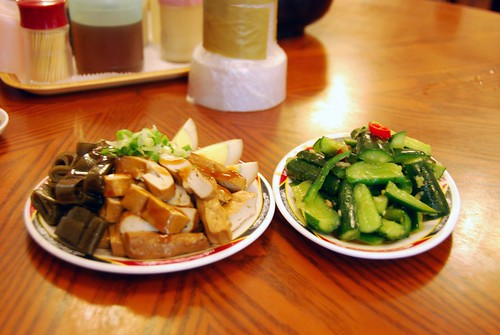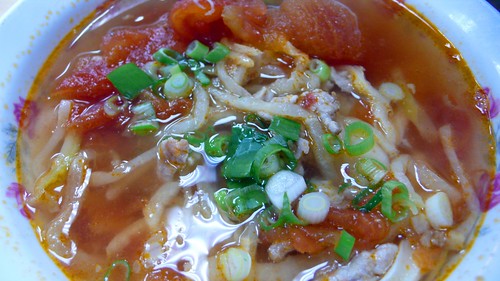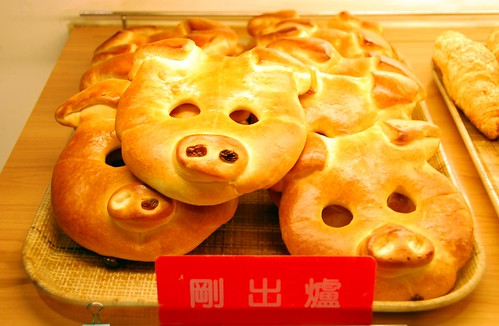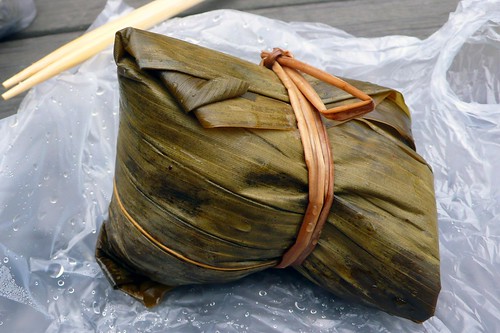Taiwan
When we told people that we were spending two months of our trip in Taiwan, a lot of them had the same reaction: “WHY?!?” Many people couldn’t understand why we would want to spend such a large portion of our of trip on such a tiny little island. Well, guess what? After two months on Isla Formosa, I can’t think of a single reason why someone wouldn’t want to spend two months or a year or maybe five in the Republic of China. I know that we’ve been effusive about several countries so far (New Zealand and Vietnam in particular), but I have to say that tiny Taiwan packs a big enough punch to (maybe, just maybe) take the “favoritest country” award. We LOVE Taiwan. Taipei is the only place so far on out trip where we can actually (realistically) see ourselves living for an extended period of time (as long as we bring a bike for Jeremy when we return), which says a lot about how highly we regard the place.

Sunset view from our apartment in Taipei.
At first I thought that I was perhaps a tad bit biased due to the fact that my parents grew up here, but given Jeremy, Kara, and Patrick’s reactions to the RoC, I have come to a conclusion: It’s Not Just Me. For a good month into our stay in Taipei, Jeremy was still turning to me daily to exclaim, “I didn’t realize how good it was going to be here!” And he’s right…the food is out of control, the people are incredible, and there is amazing natural beauty right in middle of Taipei. Most of all, Taiwanese people truly seem to live according to their values, and they work together to achieve a peaceful, orderly, and safe society. In short, we respect the way of life here, and the population that cooperates (without coercion) to make that way of life a reality.
But beyond all the high-minded talk about social values, Taiwan was a special experience for me in a personal way, too. I paid respects to my great-grandmother on Tomb Sweeping Day. I saw the town where my mother was born (Chiayi). I visited the city where my Dad went to college (Keelung). It’s hard to explain, but I feel like I understand so many more details about my family now: where they get their habits, what motivates their decisions, why they taught me the lessons they taught me. Being in Taiwan was a big turning point for us, not only because we celebrated 6 months of travel here, and not only because we spent enough time here to really get to know the place, but also because we found another place on this big blue marble where we felt like we actually belonged.
Days spent here: 54
Highlights: Well, quite frankly, everything. But in particular, Alishan, Taroko Gorge, and Taipei. Oh yeah, and let’s not forget the food.
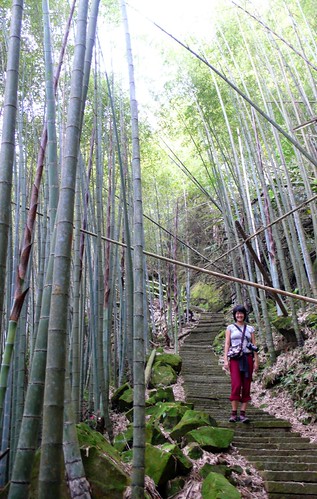
In the Green Tunnel bamboo forest, Rueili.
Places we would like to visit next time: The south, and the islands.
Average daily expenditures: approx. US$75 (note that we did not pay for housing, though our classes were a big chunk of our daily expenditures)
Prices: Taiwan cannot be considered cheap by Asian standards. Food and transport are quite affordable, but clothing and other necessities can rival American prices. If you’re not lucky enough to have grandparents who own an apartment in Taipei, housing can be spendy. Even the cheap hostels in Taipei charge at least US$30 for a double room (which is expensive given that similar rooms in SE Asia are between US$6-15). Once you get to the tourist towns outside of Taipei, however, homestays are an option, and are typically good value for the money.
Weather: In two words: totally schizophrenic. The first day we arrived in Taiwan, we pumped the AC in the apartment because it was so hot and humid outside. Two days later, we were wearing long underwear and down jackets. It seems that spring in Taiwan is not a gradual change from winter to summer as it is in other countries. Rather, the weather gods just decide that it’s summer one day and winter the next, which can be quite confusing to both your body and your wardrobe!
Also, the weather forecast (in particular the forecasts from American sources like Google and Yahoo) are just straight-up wrong. If the Google forecast says that it there is a 100% chance of rain, prepare for heat. If it says that it will be sunny and warm, bring your umbrella and your long underwear. The nightly news forecasts are a bit more accurate, but they are still only right about 60% of the time.
Language: I won’t lie, it would be somewhat difficult for a non-Chinese speaker to get around Taiwan, especially once you get out of Taipei. Kids here learn English for their college entrance exams, but when it comes to actual conversational English, well, let’s just say communication can be difficult. Still, Taiwanese people are incredibly, aggressively helpful, so if you can’t speak Chinese, they’ll probably go looking for someone who does, even if they have to go way out of their way to do it.
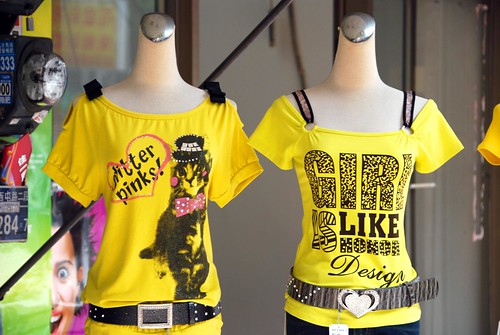
T-shirts with funny Engrish. I’ve always thought girl is like honor design, don’t you agree?
Transit: Taipei is a transit nerd’s (ahem, Eddo) heaven. The bus system is cheap (NT$15 or approx. US$0.45 per ride), and routes cover the entire Taipei metro area (though they may be a tad slow for those in a hurry). The bus routes in Taipei can be a little bit difficult to figure out, as there are no English bus route guides. But if you know the name of the place you want to go, someone can help you figure it out. The seats in the front of the bus are reserved for the elderly, pregnant, or otherwise needy, and at times I found it quite stressful trying to figure out who was too old to stand and who was just fine without a seat. So, if you’re overly-neurotic about being nice to old people like I am, just head towards the back of the bus.
An alternative to the bus in Taipei is the MRT (subway), which is fast as a whip, modern, super affordable, and ultra clean. Even the public toilets in Taipei Metro stations are impeccable, which we find astonishing (imagine going to the bathroom in BART or the NYC subway…ew). . MRT routes are not as extensive as the bus routes, but they are building new lines all the time (the line that will run on Nanjing East Road near my grandparents’ apartment is scheduled to be completed in 2012).

Train schedule posted at Taipei main station.
If you want to get out of Taipei, a train ticket is, well, your ticket. Taiwan has two train systems: the high-speed rail (which can whisk you from the north end of the island to the south in 3 hours), and the regular train, which is still pretty fast but stops more often. We never rode the high-speed train in Taiwan, partially because tickets cost twice as much as the regular train, and partially because the high-speed train stations are often out in the middle of nowhere (which means a high-speed rail trip could end up taking the same or even more time once you factor in cab/bus rides to your final destination). The high-speed rail is built for a Taiwan that doesn’t exist yet, one that looks towards the future, when urban sprawl finally reaches those fancy train stations out in the boondocks. In the meantime (meaning the next 10-15 years), the regular train will be just for us, thankyouverymuch.
Shopping: Taiwanese peeps sure like to get their shop on! Indeed, it seems more like a hobby here than just “something you need to do in order to get stuff.”
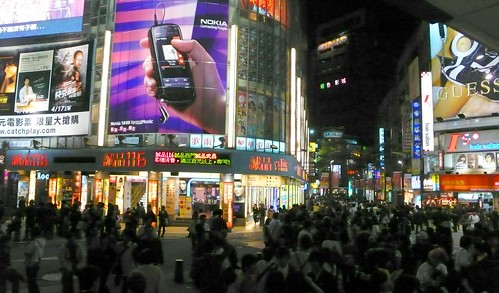
Ximending, Taipei, where you can observe teenagers in their natural habitat.
The Taiwanese system of discounts can be quite confusing to Westerners. When Taiwanese shops have sales, they do not say “30% off!” In fact, the discount is marked in the exact opposite manner, as “70% of the price.” I know, it’s confusing! To add to the confusion, discounts are denoted with the character “折,” which means 1/10th, or 10%. So a 30% off sale will be announced with a sign that says “7折.”
And, good luck finding your size. Women in Taiwan are tiny; not just short, but skin and bones. I wear a 6/8 in the States, but an XL in Taiwan. A lot of cheap clothing sold at the night markets is “one size fits all,” which is totally accurate if by “all” you mean “size 0.” Still, there are good deals to be had for “big” girls like me, you just have to look.
Internet: Internet coverage in Taipei is great, as long as you purchase a WiFly card from any one of the 17 gagillion 7-Eleven stores they have in the city. You can get a card for NT$500 (approx US$15), which gives you access for a full month; WiFly has blanket coverage in Taipei (even in the subway!) so it’s very convenient. Outside of Taipei, we had no problems with coverage either; our hotels/guesthouses usually offered access.
Food: I know, I know, I’ve already written a novel about the food. But I just have one more thing to add, OK? So just bear with me.
Wanna know why the food is so good in Taiwan? I mean, besides the fact that the climate makes for some of the freshest veggies and the juiciest, sweetest fruits we’ve ever tasted. It’s because of the Communists. Seriously. All those people that fled the mainland during the Cultural Revolution? Well, they brought the best of their regional cuisines to Taiwan. Take all that variation in flavor, mix in some amazingly fresh produce (and meat) (and while we’re at it, fish), and simmer until you’ve got a culinary explosion. Add soy sauce and vinegar to taste.
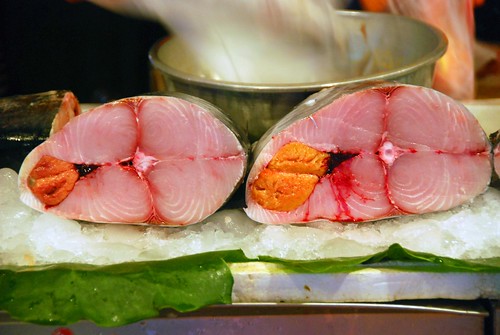
Fresh fish (with roe) for sale at the local market.
Hot springs: The hot springs in Taiwan are ah-mazing! But watch out…they can be ridiculously hot (the hottest pools often get up to 110°F), though most hot springs have several different pools of differing temperatures so you don’t have to be cooked like a human lobster (unless you want to).
There are so many hot springs in Taiwan that there is really one to please everyone. We’ve been to hot springs that cost US$1 and seen hot springs that cost US$50; hot springs where people are wearing wetsuits, and hot springs where everyone is naked (except for shower caps, for some reason); we’ve even been to hot springs with tea and bamboo infused waters, giant water slides, and pools with tiny fish that eat the dead skin off your feet!
Hotel Alert: Taiwanese like their beds hard! Not just firm, but straight-up hard. Jeremy and I like a firm bed, but it can get pretty ridiculous in Taiwan. In fact, I found out (about 1.5 months too late) that I had been sleeping on a wooden board in my grandma’s apartment. Apparently, the beds weren’t hard enough for my her, so she put some batting on top of a wooden board and slept on that. Needless to say, I was pretty upset when I found out.
Also, this is kind of perplexing to me, but Taiwanese people use hand towels as bath towels. I have no idea why, but we couldn’t find a towel larger than a square meter in my grandma’s apartment or in either of the hotels we stayed in while we were in Alishan.
In short: Taiwan RoCs! We haven’t been this sad to leave a country since New Zealand. We *will* come back here one day soon, perhaps with our little pups in tow so they can learn Chinese in the motherland too. ![]() ‘Nuff said.
‘Nuff said.
Note: A few days before we left on our China tour, my parents flew to Taiwan to meet up with us. My Dad has (unbelievably) not been back for 23 years!!! Their social schedule immediately filled up, and we were whisked from restaurant to restaurant, invited by various shu-shu’s and a-yi’s that have known my parents since they were in college…junior high…even elementary school! Taipei is a completely different place now, and it was really fun to wander around with my parents and hear their stories about places they used to hang out, their old neighborhoods, and how things have changed. Here are some additional thoughts from my Dad on the country where he grew up.
Wendy and I have planned for quite a while to join Hope and Jeremy in the middle of their around-the-world journey. We got to Taipei on May 11 and left on May 15 for China, where our family (including Eddo) will tour some of the historical and famously beautiful sceneries. I am pleased to be a guest blogger to say a few words about our Taipei staying.
Taiwan, especially Taipei, is the place like our root where we grew up and had our education through college. I finished my college in 1968. Right after I graduated, I served the Navy as a navigation officer (rank: 2nd Lieutenant). Then, in 1970, I got admission to went to New York studying oceanography and marine science. Two years later, I came back to Taipei to visit my parents and to “cure” my “homesickness.” I met a beautiful Cathay Pacific Airlines ticketing agent and asked for a date. Eventually, she married me two years later and went to New York in 1974 to be with me.
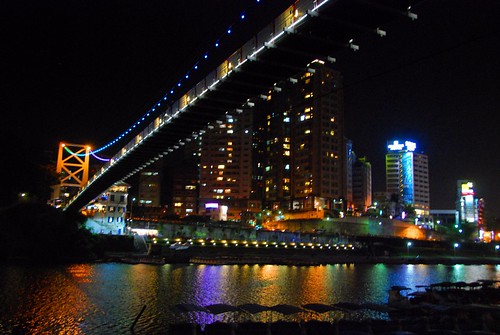
The Xindian River. In my parent’s time, this used to be “Lover’s Lane.” Now there is a boardwalk with upscale eateries lining the waterfront.
Therefore, both Wendy and I have tons of bygones here in Taiwan. In the last 26 years, however, I have only set foot in Taiwan twice: once in ‘83 (for shorter than 2 weeks), and again in ‘86 for only three days. Therefore, after I landed at Taoyuan International Airport, this place looks different and actually foreign to me. My feeling of “homecoming” is like the story of Rip Van Winkle’s coming home after a dream in the forest.
Some of my friends invite us to a dinner. Mr. Liu Hui Sheng and I were neighbors in 1955, but we have not seen each other for over 35 years. Mr. Chang Er Liew was my best friend at the time before I left Taiwan. there were many, many nights I slept over at his little “den” and got up late next morning for school. We did many silly things together and never hurt each other. Those were my “Bohemian youth buddies.” Si-wei, who is Mr. Chang’s elder brother, last time saw me before 1981. And both of us are in our 60s now, Can “time flies like an arrow” describe our feelings?
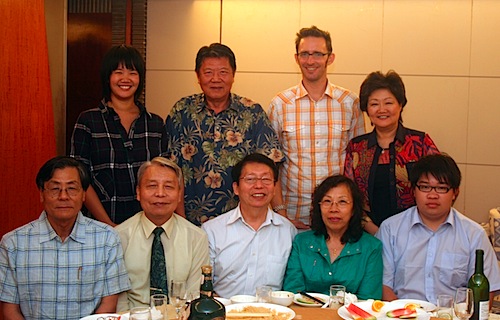
Out to dinner with my Dad’s old buddies. Top row: me, Dad, Jeremy, Mom. Bottom row: Liu Hui Sheng, Chang Si Wei, Chang Er Liew, his wife, and son.
Jack Chia and Edgar Chang are two of my Navy friends. Oh well, the three of us were handsome Naval officers before and now either baldy or with grey hair. And, both of them have been “promoted” to be “grandpa” (OK, Hope and Jeremy, no pressure or any implication here from me, all right?).
On the second day of our arrival, I got hold with my cousin, whom I have also not seen since 1981. I had heard my aunt who is 95 years old and in her last stage of life. She has been bed-ridden and unconscious for some time already. I went to the hospital to see her. She laid in bed with all kinds of tubes connected to her nose and veins. Cousin Kuo-Ching announced my presence to her left ear, and I bent down next to say “Auntie, here I am to see you, please take care.” She had no response whatsoever, yet she looked so content and peaceful. She was a beautiful woman in her heyday, and to be honest, even at this stage, her skin looks very smooth with her short hair in silver grey. My tears came down to my cheeks. But, I believe, even in her deep sleep, she knows I am with her and also I love her dearly.
Well, Taipei’s weather is too hot for me. It’s been in the 80s, and this is only early May. Transportation, it has transit system which is convenient. Buses are confusing for me, because there are quite many bus routes run by several bus companies. But, they are all air-conditioned and not like the “sardine can” that I remember.
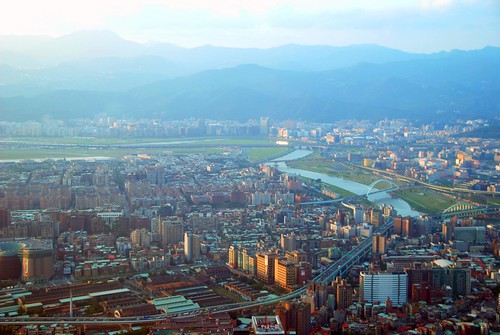
View of our neighborhood from Taipei 101 (click on the photo and you will be taken to the photo’s Flickr page, where I point out our building). Apparently this entire region of Taipei used to be rice fields.
Streets, roads, buildings, have changed too much. I still can find the old neighborhoods, but I do not recognize any new environment anymore. Taipei, my home for 22 years, looks like a strange place. My home now has to be Chula Vista, CA.
For 2 years prior to leaving on this trip, I worked at an awesome design studio called NOON in San Francisco. A few years back, a guy named Allen joined our little family as a freelancer for a few months before returning to Taiwan to do his required military service (he is a Taiwan citizen). Allen and I also went to art school together at CCA, but he was a semester ahead of me, so I didn’t really get to know him until we were coworkers.
Lunchtime (and food in general) is a really big deal at NOON, so I was sure to call Allen as soon as we got to Taiwan, because I knew he would know where the really good food was. ![]() We didn’t end up getting together until our last weekend in Taiwan, but we definitely made up for lost time!
We didn’t end up getting together until our last weekend in Taiwan, but we definitely made up for lost time!
Allen lives in Taichung, the third largest city in Taiwan after Taipei and Kaohsiung. It’s in western Taiwan, an area we hadn’t traveled to at all, so we boarded a train to Taichung and got there just in time to hit the night markets with Allen.
Now, before we get into all the crazy stuff we ate, let me explain the night markets in Taiwan: they are amazing! It’s literally fun for the whole family, and vendors sell everything from false eyelashes to cheap t-shirts with bad Engrish grammar. But the best part of the night market is the food. Typically, you go from stall to stall trying out all the strange and exotic treats on display; it is not unusual to eat about 10 different snacks in one trip.
In Taipei, the night markets are a little too crowded for our tastes, with wall-to-wall people pushing you through narrow alleys crowded with vendor stalls. So Jeremy and I hadn’t really done the whole “eat-10-different-snacks” thing at the night markets. But with Allen as our guide in Taichung, we finally cut loose! Yes, folks, we ate the infamous stinky tofu!
And it was good! It definitely is not as pungent tasting as it is smelling…and the nice, thick layer of cold pao cai (pickled vegetables) on top adds a nice temperature and texture difference to the deep fried stink. We also ate duck neck and intestines (also REALLY flavorful; the vendor chops the various parts up into little bite-sized bits so you don’t FEEL like you’re eating a duck’s neck):
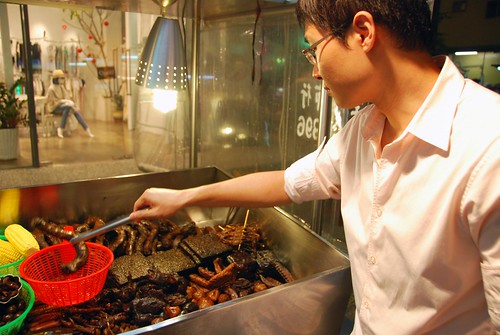
Allen picking out our duck neck and intestines.
We also tried octopus balls (like meatballs, but made out of fish and octopus—not actual octopus balls), a soup with blood and rice cakes, something called mian xian (a thick noodle soup), eggets, delicious popcorn chicken, boba tea with soy milk, and an oyster omelet.
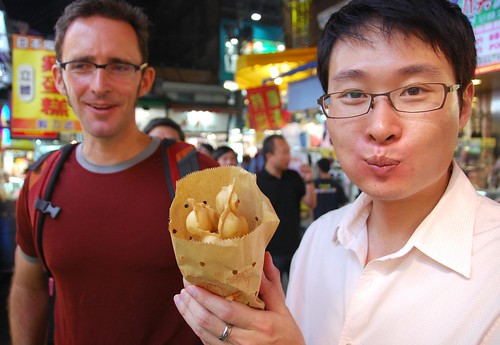
J and Allen enjoying our eggets.
I kept thinking how proud the NOONers would be of us, given all the scary stuff we ate (and also how I wished they could join us)!
The next day, we headed to one of Taiwan’s big tourist attractions, Sun Moon Lake. Allen brought his nice friend Mo along for the ride, and we had a great time chatting with them on our way up to the lake.
Sun Moon Lake isn’t actually that great; it is super commercial and the gorgeous lake scenery is a bit scarred by the development that has gone on around the shore, but it was a beautiful day and we were only there for a few hours, so the commercialism didn’t bother us too much. We took a short cruise around the lake and then drove to a nearby Confucius temple, which was really stunning, both inside and out.
We headed back to Taichung and ate some more…this time, we had mango bao bing (fresh mango and sweetened condensed milk over shaved ice) and duck wings. Afterwards, Allen wanted to take us shrimp fishing. We really had no idea what this meant, and quite frankly, we thought it sounded kind of boring, but we had a couple of hours to kill before we headed back to Taipei on the train, so we figured what the heck…when in Taichung…
It turned out to be surprisingly fun! Basically, you shrimp fish at a restaurant that has a giant kiddie pool in the middle, surrounded by tables. You pay by the hour and upon entry, you are handed a rod, a net, and a hunk of cow liver. You slice up the liver and attach it to your hook…and then you wait until a shrimp bites. And these guys are HUGE, like the size of your hand. Every hour or so, this guy comes out of the back with a bucket of shrimp and throws it in the water, hopefully near your hook. ![]()
Between the four of us, we only ended up catching 3 shrimp in our alloted hour, but luckily you can buy more shrimp by the kilo. There is a broiler right next to the pool, so you bring your catch over there and roast your shrimp up with some salt. Mo goes shrimp fishing 2 or 3 times a week, so knew what he was doing and took charge when cooking our haul. In a few minutes, we ere feasting on our freshly-caught (and bought) shrimp!
We had an awesome 24 hours in Taichung…Allen and Mo took really good care of us and totally pulled the Taiwanese custom of paying for everything behind our back. Allen and Mo, please let us know if you are ever in San Francisco! Hopefully we can return the favor!
Note: We’re in China! Or, more correctly, The Meng’s are in China…on an EATING tour (hide the women and children)! J and I met up with my parents (in Taipei) and my brother (in Shanghai), and we’re touring around central and southern China together for the next two weeks. This is my Mom and Eddo’s first time in the (grand)motherland!!! Postings might be sporadic during this time, as we’ve got a jam-packed tour schedule…but we’ll make up for it with guest posts from my Dad and Eddo coming soon!
While Kara and Patrick were visiting us in Taiwan, we did some traveling around the North and Eastern part of the country, but we also did some old-fashioned sight-seeing around Taipei. Since Jeremy and I are in school most of the week (and we typically head out of town on the weekends), we still hadn’t visited some of the major sights around Taiwan’s capital. So, we were excited to check out some of the sights that Taipei has to offer, and to share that experience with K & P.
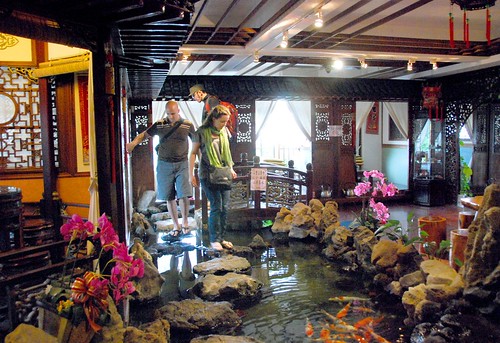
Crossing the koi pond in Yuan Xu Yuan teahouse.
Maokong is a suburb of Taipei, and it’s best-known attraction is a gondola that ferries you from the Taipei Zoo MRT station up into the hills, where you can wile away an afternoon in one of many quaint little teahouses. Unfortunately, after we arrived at the zoo, we found out that the gondola was out of service (boooo), but we took a bus up the mountain instead and spent the afternoon in Yuan Xu Yuan teahouse, enjoying a gorgeous view of the city and munching on various steamed baos. Tearooms in Yuan Xu Yuan are built over a koi pond, with acrylic floors so you can watch the fishies swim around underfoot. To access the tearooms, you have to walk across some stone steps submerged in the koi pond.
That evening, we headed up to the top of the Taipei 101 (which I believe is still the world’s tallest completed building) to watch the sunset. The super high-tech elevator takes you up 89 stories in 37 seconds. Despite the fact that there were huge tour groups full of pushy mainlanders gettin’ all up in our personal space, it was a really pleasurable experience, as the view is truly breathtaking.
We also had a rather funny day that involved biking around the tea fields of Pinglin…I say “funny” because it was one of those days where nothing goes your way. “Biking around tea fields” sounds really romantic, but in reality, it took us FOREVER to get out to Pinglin, and when we finally arrived at our destination, we found out we had to drive another 30 minutes to get to a bike rental shop. The bikes were in horrible condition, and the tea fields were hillier than we thought they would be, which made for a much sweatier, more strenuous experience than we were expecting. As Patrick says, “sometimes you eat the cookie, sometimes the cookie eats you,” and we’ve eaten a LOT of cookies in Taiwan, so we weren’t too upset that things didn’t go our way that day. ![]()
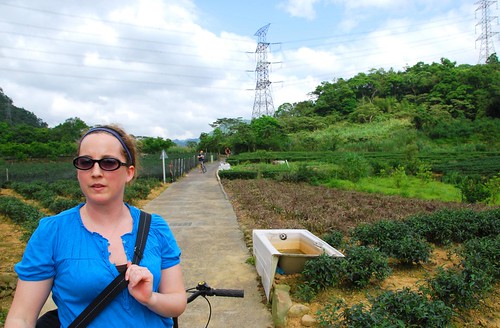
K, working off some XLBs through Pinglin tea fields.
Chung Kai Shek Memorial Hall—which is sort of the unofficial town square of Western Taipei—was the site of another one of our adventures…this time we had a little more luck on our side; the day was gorgeous and a huge Tzu-Chi group (China’s largest Buddhist society) was rehearsing some sort of performance: they wore navy blue and white outfits that matched both each other and CKS Hall!
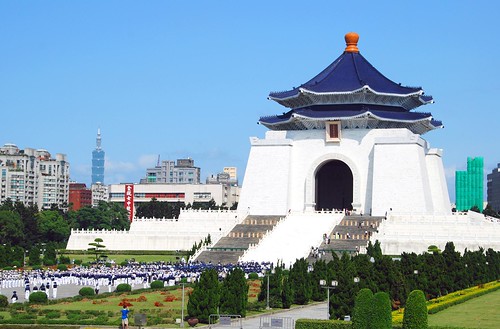
Chung Kai Shek Memorial Hall, with Taipei 101 in the background.
And, of course, we’re in Taiwan, so let’s not forget about the food! We had so many amazing meals (too many to recount here), so let’s just cover some of the more unusual highlights: we spent one night in Shilin (site of Taipei’s biggest night market) and tried the fried chicken, which is dusted with chili powder and served up piping hot in a plastic bag. No wonder it was the longest line at the Shilin food court…it’s finger lickin’ good!
For K & P’s first day in Taiwan, we took them to eat at world-renowned Dintaifung (home of the planet’s most famous xiao long bao, with branches in Hong Kong, Shanghai, and Los Angeles). This was Kara and Patty’s first encounter with an XLB, and of course, they loved it! Actually, we may have created two XLB monsters…watch out Jersey City! ![]() We all liked the meal at Dintaifung, but as P & K got to know Mr. Bao better, I think we all eventually agreed that DTF is kinda overrated. We liked Kao Chi better (just around the corner from DTF’s Xinyi Street location)—and it’s cheaper, too!
We all liked the meal at Dintaifung, but as P & K got to know Mr. Bao better, I think we all eventually agreed that DTF is kinda overrated. We liked Kao Chi better (just around the corner from DTF’s Xinyi Street location)—and it’s cheaper, too!

Shrimp-topped pork shumai’s at Kao Chi.
But our most memorable meal was dinner at the Golden Dragon restaurant in the Grand Hotel (one of Taipei’s major landmarks, featured in Eat Drink Man Woman), courtesy of Momma Fusco. We had an absolutely fabulous meal at a table overlooking the Keelung River at night, and the hotel wasn’t too shabby, either. It really was a special treat because Jeremy and my travel budget does not allow for many (ahem, let’s make that “any”) expensive meals, so it was quite a change of pace for us to see how the other half lives in Taipei! Thanks Momma Fusco!!!
And once again, a thousand xie xie’s to K & P for coming all the way out to Taipei to visit us…you guys are the number one wai guo ren’s in our book! By the way, HAVE YOU BEEN TO CARREFOUR?!? ![]()
Note: We have a special treat for you today! Kara wrote this awesome guest post about the 3-day trip we took to Taroko Gorge. Thanks to K for lending us her voice…and thanks again to K & P for coming out! It means so much to us to share this adventure with you. We love you!!!
If only we could do it all again! Patrick and I would eagerly join Hope and Jeremy on the other side of the globe again to share in a little slice of their adventure. (And I would do it just for the sight of Hope’s hands waving in the air as she ran out to meet us after our cab dropped us off from the airport.) We spent a sparkling 10 days with the Menghermanns in Taiwan, and can wholeheartedly second that: Taiwan is awesome. We discovered new things to impress us and enjoy every day—even stopping in 7-11 to use an ATM was an adventure! (Which makes me empathize with Hope…it’s difficult to write a blog post on one subject when really, there is so much to share!)
In the midst of our Taipei sightseeing and day trips to hot springs and teahouses, the four of us took a three-day jaunt to Taroko Gorge, one of the island’s biggest tourist draws. An 2.5-hour express train south from Taipei Main Station brought us in around noon to Hualien, gateway town to the Gorge. We totally scored with our hotel: the (un-inspiringly named, but inspiringly decorated) No. 6 Homestay (http://hs101.com.tw/index.php). It’s owned and run by a supercute husband and wife team and their sporty retriever, Kuchi (see photo of Kuchi here, complete with polo shirt and adorable buckteeth).

With our Hualien homestay family. You can see Kuchi strolling out of the photo into his doghouse on the right side of the photo. Check the lion cut!
Our homestay family picked us up from the train station (Hope told them to look for the four wai guo ren’s standing in front of the Visitor Info Center! Ed. note: Actually, I said: “I am really tall and I’m with 3 wai guo ren’s. You can’t miss us.”), took our breakfast orders for the next morning, and held onto our bags because our rooms weren’t ready and we were eager to get our hike on. A little back ’splaining: Taiwanese and Chinese, the main tourist population in Taiwan, really like their tour groups and massive buses (Ed. note: I found out later that people from the mainland are actually required to travel Taiwan in tour groups. Guess the Taiwanese are a little worried about Chinese people running around their country no-holds-barred). So there was a lot of pressure to take a tour bus of the Gorge. Really?! Being bull-headed, do-it-on-our-own Americans, we took a cab the 30 minutes into Taroko National Park and our driver dropped us off at the Shakadang trailhead [insert your Chaka Khan reference here].

The boys on Shakadong Trail, Taroko Gorge. The river water is naturally that vivid blue color.
After shakadangin’ an easy, very pretty 3-hour hike along a river, we caught the slow public bus back to Hualien from the park’s visitor center. We’re crediting Patrick with the next brilliant idea: next door to the Hualien train station, we rented two red peppy scooters for NT$400 (approx. US$12) per 24 hours. Awesome! We were able to zip over to a night market area and feast on what ended up being some of the most memorable XLBs of our trip. (According to Hope’s reading, these were Taiwan-style, with a thicker, spongey dumpling exterior, as opposed to the Shanghai-style XLBs we’d been eating in Taipei. They were so good that we felt the need to dine on them BOTH nights in Hualien!) And the next morning, we scooted off happily on our own time schedule to hit some of the main sites and trails in gorge-ous Taroko.
Our drive into the park was thrillingly beautiful…the roads are narrow and curvy and we had the best of both worlds, pulling off often to snap photos and yet zooming around those smelly tour buses.
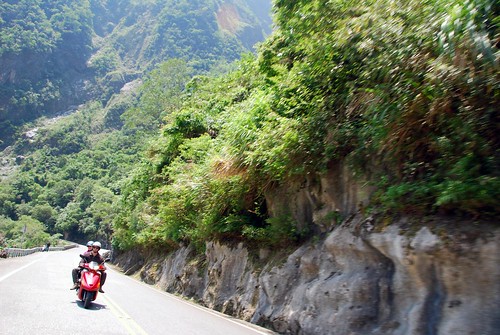
K & P scootin’ through the gorge-ous scenery.
The park’s landscape consists of mountains, gorges, rivers, and waterfalls….all great to soak up from a bike.
At one stop, we climbed up to a Buddhist temple and Japanese pagoda.
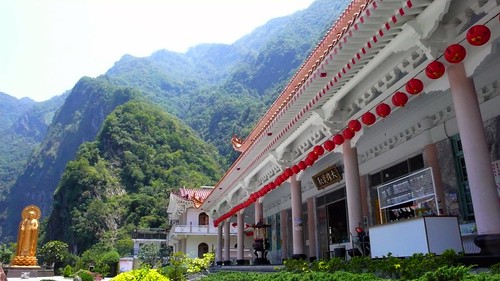
Beautiful Hsiangte Temple in Tienhsang.
And on the moderate Baiyang waterfall trail, we hiked through several long dark tunnels (perfect for practicing our “Muhahaha’s” and witch cackles!), crossed a suspension bridge…
…and, following the example of some generous tourists who passed us their rain ponchos, we took off our shoes to wade into a watery tunnel with a waterfall coming right out of the ceiling!
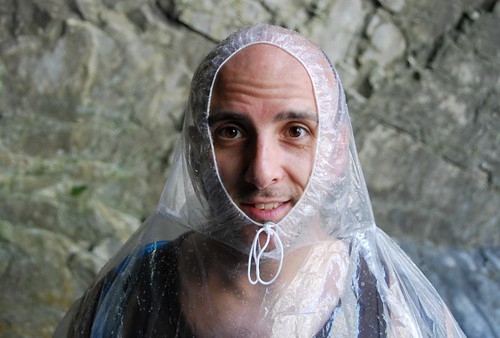
Patty, all suited up to explore the Baiyang waterfall.
Our third and final day in Hualien, we scooted to Liyu Lake where we made a valiant attempt to chew Taiwanese beetlenut (verrrry bitter, if we could have stuck with it, it’s supposed to product a nicotine-like buzz), and hiked up a mountain trail for great views.

Sorry, K, but this photo was too funny not to post! For the record, this is what I looked like too when I tried to chew betelnut.
Our trail method: the person in the front carried the Spider Stick (to knock down any stray webs across the trail), which after a slithery sighting turned into a Snake Stick, and then needed to be exchanged for an even larger branch once we encountered a largish gray monkey.
Hands down, our favorite thing about Taiwan is the people. Taiwanese people are friendly, accommodating, enthusiastic, and even the “aggressive” helpfulness is endearing. The four of us made quite a scene wherever we went because there aren’t many Caucasian travelers. Taiwan isn’t particularly affordable, especially compared to its southeast neighbors. And it’s difficult to get around if you don’t speak Chinese. (Incredible props to Hopie for navigating and guiding all four of us in and out of restaurants, shops, and public trans!) We were a sight: an extra-ordinarily tall Chinese Hope (”Sheee’s so taall!”), an even taller Jeremy, a Patrick with his shaved head, and a short curly-haired Kara. We received many stares, quite a few points and giggles, and even a few peace signs. Though remember who you’re dealing with….We go to Burning Man and dress up in costumes like it’s our jobs. So there isn’t any shame in our game. Which helps in random, awesome instances like when sweet older ladies approached our lunch table, passing out information on a political candidate. Patrick could barely get out, “I only speak English” before our table was swarmed and we were shaking hands and taking pictures with a famous Taiwanese Senator whose face we’d seen plastered on billboards.
Last week, my best friend Kara and her husband Patrick flew from New Jersey to come see us. I can’t tell you how exciting it was not only to see some familiar faces, but to be able to share this amazing travel experience with people that we love. This year-long journey is obviously a huge event in our lives, and sharing it with people who have known you for almost your whole life not only deepens our experience of the trip, but it deepens our friendship as well.
We did a lot of wandering around Taipei, and a three-day trip to Taroko Gorge (more on both of those later), but we also enjoyed a great day-trip to Jiufen. Patrick picked the spot, which was really cool because I don’t think Jeremy and I would have gone there otherwise…and it was a really cool experience! We had also planned on going to nearby Jinguashi, but kinda ran out of time in our languid wanderings. Oh well, next time!
You have to take a bus from the train station in Ruifang to get to Jiufen; it motors you up this a crazy-steep mountainside with beautiful views of the ocean. When we got off the bus in Jiufen, there was a huge commotion at a nearby temple…turns out it was some local god’s birthday and they were having a huge celebration in honor of the event.
The giant dancing heads were amusing, especially when they started doing this N-Sync era hip-hop style choreography (I’m not joking), and we plugged our ears in an effort to stop the firecrackers going off about 10 feet away from us from rupturing our eardrums. But the biggest WTF moment of the day happened when we saw a bunch of guys hitting themselves in the forehead with knives and bleeding all over their own faces. If you want to see a photo of this, click here…I won’t force those of you who are squeamish about blood to look at it.
After the excitement of the temple, we headed for the excitement of Jiufen’s Jishan Old Street, a long, narrow lane filled with snack vendors, knick-knack shops, and tea houses…and the smell of vendors frying up stinky tofu. Kara was totally appalled by the aroma…which is funny, we barely even notice it anymore! I haven’t mentioned stinky tofu on this blog yet, but it is a Taiwanese specialty snack, sold at night markets around the country. The smell is truly odoriffic; I think Kara described as smelling like “vomit after you drank orange juice.” It’s hard to imagine eating it, but one couple was chomping away on a cube of it, with their eyes watering over from the pungency.
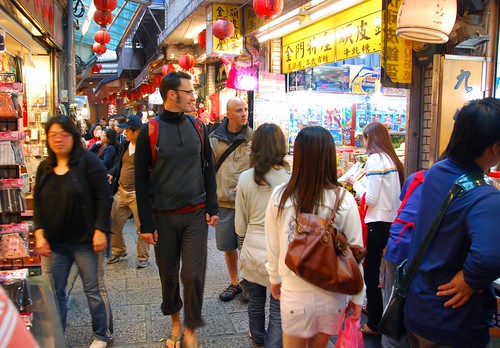
Jeremy and Patty walking down Jiufen’s Old Street.
Eventually, we made our way to the Jiufen teahouse, an absolutely gorgeous little place that fires water over hot coals and teaches you how to pour tea in the traditional Chinese way. They taught us all about warming the cups and pouring the tea from this pot to that vessel before it finally ends up in your cup.
We ended the marvelous day by heading to Jinshan on the bus and soaking in some hot springs there. We had a hot spring in mind but changed our plans when the man at the bus station suggested we check out Old Jinshan Hot Springs (http://www.warmspring.com.tw/)…once again, the aggressive Taiwanese helpfulness works to our favor!
It was an awesome day made even more fun by the excellent company. Here’s to good friends and travel! Two great tastes that taste great together!
Note: Because posts without photos are boring, and because I am a typography nerd, I will sprinkle this post with images of various Chinese characters we’ve found while in Taiwan.
As I mentioned in a previous post, we are not just in Taiwan to play, but also to study Chinese (me for reading, writing, and some intermediate grammar stuff; Jeremy for speaking). Prior to arriving in Taiwan, we researched several different language schools and settled on Taipei Language Institute (TLI), partially because they were the most professional (answered our emails right away, sent us materials about the program, etc.), and partially because we could do private lessons at an affordable price (we pay NT$380 or approx. US$11.50 per hour because we take 8 hours of lessons each per week; if you take 10 or more hours a week, it is even cheaper).
It turned out to be a great choice, as TLI is geared towards foreigners and has a unique approach to teaching Mandarin. As someone who grew up going to Chinese school every weekend, I know a thing or two about strict Chinese teachers…the traditional teaching method seems to revolve around rote memorization, making you feel guilty about not working hard enough, writing each Chinese character over and over until your hand has permanently cramped into a fist, followed by some more rote memorization. Writing, pronunciation, speaking, and listening are taught concurrently and given equal emphasis, which means that if you are starting out from ground zero (like Jeremy is), it can take you a REALLY long time before you start understanding any spoken conversation, because you spend so much time learning Chinese characters (which, as you can imagine, is, um, kinda hard!).
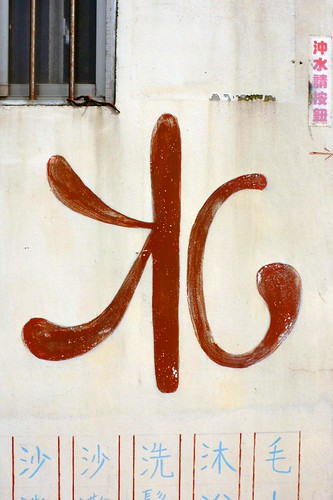
Beautifully hand-drawn character for “water.” Found in Fulong.
The TLI approach is pretty different. If you are a beginner, you learn the oral language first (listening and speaking), and after you’ve mastered some of the basics, then they teach you how to read/write. This is a pretty smart approach, and caters well to those who need a little instant gratification to stay motivated. ![]() We’ve been in class for about 6 weeks now, and Jeremy’s listening comprehension is already light years ahead of where he was when he studied with a more traditional teacher for 6+ months in the States. He picks a good percentage of the conversation when I speak to people around town, and even busts out a little Mandarin on his own from time to time! Cute story: there is a lady down the street from school who sells steamed pork buns. She is very encouraging of Jeremy…last time she made a huge commotion about how much his Mandarin has improved. Not only does she pump up his ego, but he gets a pork bun at the end of it too! Talk about classical conditioning!
We’ve been in class for about 6 weeks now, and Jeremy’s listening comprehension is already light years ahead of where he was when he studied with a more traditional teacher for 6+ months in the States. He picks a good percentage of the conversation when I speak to people around town, and even busts out a little Mandarin on his own from time to time! Cute story: there is a lady down the street from school who sells steamed pork buns. She is very encouraging of Jeremy…last time she made a huge commotion about how much his Mandarin has improved. Not only does she pump up his ego, but he gets a pork bun at the end of it too! Talk about classical conditioning!
Another interesting feature of the TLI experience revolves around the teachers. We have a different teacher for each hour of class. For me, this works out well, as I spend the first hour working on writing and reading, while the second hour is spent with a different textbook on grammatical patterns. Jeremy uses the same book both hours, so his first teacher just makes a note of where they ended and the second teacher picks up where they left off. At first we thought this switching teachers business would be confusing, but it turns out we really like it! It keeps the energy fresh and you get the benefit of two different people with two different skill sets enhancing your studies.
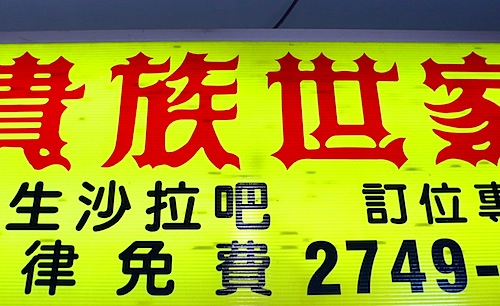
We go to school four days a week (Monday through Thursday), for two hours a day. It doesn’t sound like much, but we are exhausted afterwards! Since we are taking private lessons, the classes are fairly intense. Plus, we spend at least 2-4 hours outside of class studying and preparing for class, so most of our days are taken up with our Chinese lessons.
A while back, I described Jeremy learning Chinese as the equivalent of me trying to learn orthopedic surgery. I sort of wasn’t exaggerating…Chinese is really hard! What exactly makes it so difficult? Well, there are the obvious reasons:
- Lack of an alphabet
Pronunciation of Chinese characters cannot be deciphered from the character’s appearance. To make matters worse, often the same character can be read in two entirely different ways. Ever mindful of being efficient, Chinese people just started using the same character for two entirely different words instead of introducing new characters. Why unitask when you can multitask? Why just give a word one meaning…why not several? For example, the character 行 can be read as xing (meaning “all right”) or hang (meaning “professional”), depending on the context in which it is used. You’re just supposed to figure out how it is read based on the other words around it.Note that there are two different phonetic systems that indicate the pronunciation of a word (bo po mo fo and pinyin), but these systems are only used in textbooks for little kids…you rarely see them on signage or other printed matter out in the real world.
- Tones
Like many Asian languages, Chinese is tonal. There are 4 tones, which means that the sound ma spoken in the first tone (question word) has a completely different meaning than the sound ma spoken with a fourth tone (”to punish”). As you can imagine, it is important to get your tones right, or you can be easily misunderstood.Again, to complicate things, there are also tons of words that sound exactly the same (even the same tone) but have totally different written characters and therefore meanings. You derive their meaning based on the context in which they are spoken. Jeremy has been complaining a lot about the word jiu (with a fourth tone). It can mean: “ancient,” “at once,” “to rescue,” or “uncle.”
Those are the main reasons people point to when trying to explain why even basic Chinese is so hard to master. But even for someone whose first language was Mandarin, the more I study it, the more I realize how many idiosyncrasies there are in the language. I mean, I may not have a huge vocabulary, but I know how to put sentences together (Chinese grammar can be tricky), which is half the battle. Here are a few more weird little quirks in the Chinese language:
- So many numeral multipliers, so little time
For whatever reason, Chinese people can’t just say “a noodle,” or “the book.” There are dozens of words for the word “a” or “the.” Seriously. What they do is group things into categories and then apply something known as a numeral multiplier: all long skinny things get one type of word for “a” (tiao), all flat thin things get another word (zhang). I even learned recently that there are different numeral multipliers for the word “movie,” depending on if you want to emphasize that it is scheduled (bu), if you are going to see it in a multiplex theater (chang), or if you just want to go to a plain old movie (ge). It’s basically like saying, “Hey! Instead of saying ‘a pencil’ we’re going to start saying ‘b pencil’! And then everything that is long and skinny like a pencil, we’ll say ‘b’ too! As in, ‘I bought b really nice ribbon! I think b ribbon really brightens up a gift. And by the way, put b ribbon on c table.’” - If the glove doesn’t fit, you must omit
Even if you kill yourself remembering all the grammatical rules and linguistic constructs, you still might not understand someone when they’re talking to you. Why? Once again, Chinese efficiency rears it’s ugly head. Chinese people will omit any words that are not absolutely necessary in a sentence, while still getting their meaning across. It’s sort of hard to explain, since there isn’t really an English equivalent. But you’ll know you’re getting the hang of it when you can say a sentence with fewer words, not more (because it can be tricky to know exactly which words to omit). If someone asks you “Are you making dinner tonight?” and you say “Not make,” rather than “I am not making dinner tonight,” give yourself a pat on the back…you’re an advanced Chinese speaker now!
So yeah, we’ve sort of got our work cut out for us. I’m choosing to see this as an education that may take a lifetime, rather than something that I can master in 6 months or a year or 5 years or whatever. By the end of our time here, I will probably recognize close to 1000 characters. I was really proud of myself until my teacher told me today that little kids graduating from elementary school know at least 3000 characters. So let’s see, that makes me equivalent to, what, a third grader? Rock on!
I have to admit, though…I didn’t expect it, but along the way, I have rediscovered my love of linguistics and what the study of a language can teach us about a culture. Even better, the culture I’m learning more about is my own, my family’s, and one that our kids will be a part of too.
P.S. The Director of TLI asked me to mention that TLI is now offering the HSK exam (apparently some sort of test that proves your Chinese proficiency). I guess it was previously only offered in Hong Kong in Japan, but now you can take the test in Taiwan, too.
P.P.S. We’ve been using a great online Chinese dictionary at Yellow Bridge. You can look up a word by English, Chinese, or pinyin, and even handwriting recognition! It gives you all kinds of useful information like character etymology, stroke order (huh huh), and even a sound file so you know how to pronounce the word.
P.P.S.S. OK, I promise, last one…for you iPhone users out there, we found a great flashcard app called gFlashPro that we use to drill ourselves on new words while we’re taking the bus to school. You just upload an Excel file with the front of the cards in one column and the back of the cards in another. Nerd alert!
A few weekends ago, Jeremy and I took our first big overnight trip in Taiwan to Alishan National Scenic Area. Independent travel is not a big thing in Taiwan—probably because there aren’t that many Western travelers here, and Chinese people like the ease of a tour group. So, I was a little intimidated by all the stuff we had to figure out in order to get to Alishan: where to stay, how to get there, how to book the tickets, etc. Luckily, the tourist information center at Taipei Main Station will help you with all of this…seriously, the girls there went above and beyond (remember what I said about the aggressively helpful people here?): finding a cheap hotel for us, calling to make reservations, booking our train tickets and even walking us over to the counter to pick them up. They were amazing! We couldn’t have done it without them.
Alishan is located in central Taiwan on the west coast, about 250 km south from Taipei. We took the high-speed train down to Chiayi (gateway to Alishan), which took 3.5 hours and cost NT$600 each (approx. US$18). It was incredibly comfortable, clean, and spacious, and once again, we thought: damn it’s civilized here!
There are several “must-do’s” in Alishan, and the first is to take the narrow-gauge railway (one of 3 narrow-gauge mountain railways in the world or something like that?). Tickets are NT$399 (approx. US$12) one way, and it’s a good idea to book them in advance, as they often sell out and you’ll end up standing the entire 3.5 hour ride to Alishan (which can’t be fun).
It’s funny that it took the same amount of time to get from Taipei to Chiayi as it did to get from Chiayi to Alishan, even though the latter’s distance has to be about 1/10 of the former’s. Second realization: technology is a good thing. The ride, however slow, was totally worth it, as it was incredibly scenic, passing through cloud-shrouded cedar forests and mountainsides.
When we finally arrived in Alishan, it was around 5:30pm, and already quite cold: about 12°C (54°F, though it felt much colder due to the humidity). We quickly warmed ourselves with a meal of wild boar hot pot, a specialty (along with wild deer) of this region. Despite the fact that it was only about 7:30PM when we finished, we headed straight back to the hotel to bed…the other “must-do” in Alishan is to take the 4:30AM train to Chu Shan to watch the sunrise over Taiwan’s tallest mountain, Yu Shan (almost 4000m tall). I sort of doubted our mental stability over this decision, but it turned out to be awesome. Not only is the sunrise gorgeous, but the whole “cloud ocean” phenomenon here is breathtaking. Apparently we are super lucky to have actually seen the sunrise; Jeremy’s Chinese teacher has gone twice and not seen the sunrise due to cloudy skies. I would be pretty upset if I got up at 4AM TWICE and didn’t get to see the sunrise.
There are tons of people at Chu Shan…much more than you would expect with a 4AM wake-up call, but the crowds are not annoying; in fact, it was cute—everyone was eagerly awaiting the sunrise and they even started applauding when it finally happened. Also, some people buy these polarizing glasses so they can stare directly at the sun when it finally appears over the mountains. It’s awesome.
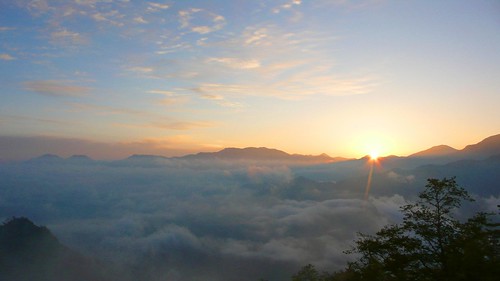
Sunrise and cloud ocean over Yu Shan, Taiwan’s tallest mountain.
Since it was still ridiculously early, we took a walk through the Alishan Forest Recreation Area, which has many beautiful HUGE ancient cedar, fir, and oak trees.
There are also some nice temples nestled amongst the giant tree forests; outside of Shouchen Temple we tried something we were calling “wild boar toffee”: they were these super-thin sheets of boar meat rolled with sesame, sugar, and nuts, and fired to a crisp. While “wild boar toffee” may not be the best marketing on our part, we promise, they were really good!
Later on in the day, we took the train back to a town called Fenqihu, a town about halfway between Alishan and Chiayi. We were glad that we only had to sit on the train for an hour, because on the way back, the diesel engine is in front of the train, spewing it’s stinky emissions straight into the passenger cars. P.U.!
Our plan was to hike from Fenqihu to Rueili, along the 10km Fen-Rui Historic Trail. We made sure to stop and grab the famous Fenqihu lunchbox, consisting of a pork cutlet and carious pickled veggies over rice. I’m not sure why the Fenqihu lunchbox is so famous…don’t get me wrong, it was really, really good and the perfect thing to bring on a hike, but most lunchboxes we’ve encountered contain the same things!
The trail navigates you through some incredible bamboo forests…I felt like we were in the middle of the movie Hero.
When we finally made it out on the Rueili side, there was a big crowd of people from one of the tour buses hanging out by the trail head. Some kids in the group saw Jeremy, the foreigner (wai guo ren), and immediately started asking him questions in English they must have learned from their schoolbooks: Do you have any brothers and sisters? How old are you? Do you like Taiwan? The little boy on the right side of Jeremy even pulled out his camera and started taking pictures of the wai guo ren!
They were very enthusiastic and they had the cutest questions. Here’s one conversation we had with the little girl on the left side of Jeremy:
Little Girl (speaking Chinese): In English, why do you say “noodles” instead of “noodle”?
Hope (also speaking Chinese): Because one strand is a noodle, and a whole bowl of them together is called “noodles.”
LG: Then why do you say “rice” and not “rices”?
Hope: That’s a really good question!
LG: Ask him (pointing at Jeremy, as if he made up the language).
And another conversation we had with the little boy who took a photo of Jeremy:
Little Boy: Ask him if he has a girlfriend.
Hope: Um, he’s my husband!
LB (amazed): REALLY?!?
H: Yes, really.
LB: How come you can speak Chinese?
H: Because my parents are Chinese.
LB: So you were born here?
H: No, I was born in the US.
LB: Then why is your hair black?
The little frowning boy on the left side of the photo was not as outgoing as his counterparts…he was so nervous around us that he would interrupt the conversation by blurting out the most random questions, like “HAVE YOU BEEN TO CARREFOUR?!?” (Carrefour is like Target/Safeway). It was kind of adorable.
After much more raucous questioning, we finally tore ourselves away and headed down the hill to Rueili, passing a mountainous landscape full of tea fields.
Even though we had had a very long day, we weren’t going to miss out on one of Rueili’s most famous attractions: fireflies! The owner of our hotel guided a group of us over to a dark path bordered by a steep hillside, and the mountain came alive with hundreds of flickering little sparkles. I obviously could not get a photo of this, but suffice to say it was magical. Growing up in New Jersey, we used to catch fireflies in little jars and it totally made me feel like a kid again seeing these magical little creatures come alive.
We HIGHLY recommend checking out Alishan if you’re ever in Taiwan. We absolutely loved it! From the incredible bamboo forests to the sparkling fireflies to the amazing tea plantations, much of Alishan felt like a little piece of magic, right in the middle of Taiwan.
While we were in Chiang Mai suffering over the food, I comforted myself with the thought that in a week we would be in Taipei, feasting like a King and Queen—the Royal Couple of Noodle-vania, as it were—and even though I’m in Taipei right now I still salivate at the mere thought of those chewy, glutinous flour noodles. SE Asia’s rice noodles are good and all, but in a noodle-to-noodle throwdown you know who would come out on top.
But really, “comfort” is exactly the right word, because this is the type of food I grew up eating. I may not know how to say “politics” or “municipality” in Chinese, but I sure as heck know my xiao long bao from by jiao zi.
Here is a primer on some of the best simple dishes that Taipei has to offer.
Dumplings (Jiao Zi)
This is a staple of Taiwanese cuisine, and you probably known them as gyoza. Jiao zi can be stuffed with all different kinds of fillings (xiar), but the most popular is minced pork or pork and leek. We’ve also tried a “Korean filling” version that is a little bit spicy, but we don’t like them as much as the good, old-fashioned pork or pork and leek versions. They can be steamed, boiled in water, or pan-fried (in which case, they are called potstickers). I like to dip them in a mixture of soy sauce, vinegar, chili sauce, and sesame oil.
Beef Noodle Soup (Niu Rou Mian)
One of my all-time favorite meals in a bowl! The beef used in this dish is quite tendinous, so it is stewed for hours on end, creating an ultra-rich broth and meat that falls apart in your mouth. Spinach or lettuce (they cook lettuce here) is added to your bowl along with noodles (your choice of thickness), and you can choose to add chili sauce and suan cai, a type of sour pickled vegetable that I just can’t get enough on.
Spring Onion Pancake (Cong You Bing)
This is exactly what it sounds like—a fried pancake mixed with spring onions. The dough is hand-rolled and the best cong you bing is somewhat flaky—they achieve this by scrunching up the pancake during the cooking process. It is so simple, but so, so good. It can be served with an egg fried on top.
Sesame-paste noodles (Ma Jiang Mian or Liang Mian)
This is a noodle dish served cold, tossed with a sauce of sesame paste (the black kind, like the stuff in the middle of mochis). It might seem a little strange to Americans since black sesame is often associated with sweet things, rather than a salty dish. But trust me, it’s good. There are usually some raw vegetables shredded on top…you mix it all up and eat it down.
Pork Buns (Zhu Rou Bao)
You are probably familiar with buns like these, filled with char siew, or barbecued pork. Char siew (or cha sao in Mandarin) buns are actually a Hong Kongnese thing; the buns in Taiwan are usually stuffed with the same pork filling as jiao zi, but the outer shell is made of soft, fluffy, and semi-sweet bread-like dough. We’ve also discovered a really delicious vegetable version filled with cabbage and spring onion (pictured on the right side in the photo below).
Soy Milk (Dou Jiang)
A very common Taiwanese breakfast consists of a bowl soy milk, served either sweet or salty. Yes, I said salty. And yes, it sounds weird, and for a long time, I wouldn’t eat it this way, but I’ve grown to like the salty version (though I still usually order it sweet). Salty soy milk usually includes some pieces of you tiao (which is Chinese fried dough), spring onions, pickles vegetables, and ginger. Chinese soy milk tastes almost nothing like American soy milk; it is chalkier and has more of the bean flavor than its American counterpart. It is often eaten with cong you bing (in this case, fried with an egg) or something called sao bing-you tiao. Sao bing is a flaky pastry covered in sesame seeds; it is shaped like a small envelope and indeed, you split it open and sandwich a you tiao in the middle of it. You tiao is often referred to as a “Chinese doughnut,” but I disagree with this assessment, as they are not sweet at all. Basically, it’s just fried dough.
Za Jiang Mian
Za jiang is like the bolognese of Taiwanese food, but obviously with a Chinese slant. The sauce is made with minced meat, soy sauce, and fermented beans. This version also has some baked tofu and steamed bean sprouts added. Also note that this particular version of the dish is made with dao xiao mian, or knife-cut noodles. A guy stands over a boiling pot of water, holding a huge block of dough in one hand and a special knife in the other, shaving off noodles off the block straight into the boiling water. He might as well just shave them straight into my belly, given how fast we gobble this stuff up.
Little Dragon Dumplings (Xiao Long Bao, aka XLB)
Kind of like jiao zi, except with a soupy surprise inside! Xiao long bao are stuffed with minced pork and they are ALWAYS wrapped in this way (with a little twist at the top). The chef wraps a frozen chunk of soup stock into the center of each bao before they are steamed to perfection, so when they come out of the bamboo steamer all piping hot, each bao will explode into your mouth with porky, soupy goodness. If for some ungodly reason I am given only one more meal to sustain me for the rest of my life, please let it consist of XLBs.
Cold Appetizers (Xiao Chi)
Most places that sell simple meals revolving around noodles or jiao zi will also offer cold appetizers so you can, you know, get some nutrition along with your carbs (what a concept!). You can order any number of things from sliced meats to intestines to pig’s ears. Since we are wusses and are too afraid to eat things like pig snouts, our favorites are the cucumber salad (small mini-cucumbers crushed up and tossed with chili, sesame oil, and vinegar), and the plate on the left, which consists of baked tofu, seaweed, and cha ye dan, or tea-leaf eggs. Basically, the eggs are hard-boiled in a tea-leaf concoction, turning them dark brown. They sell tea-leaf eggs in the 7-Elevens around here and rumor has it that each store (and they are ubiquitous here, like one every block) sells two huge boiler pots full of them every day. I guesstimate that each boiler pot holds about 60 eggs…that’s 120 eggs for EACH store!!! They must sell tens of thousands of tea-leaf eggs each day in Taipei alone!
Tomato and Shredded Pork Soup (Fan Chie Rou Si Tang)
I’m not sure if this can be considered a common dish in Taiwan, as I have never had it in a restaurant before I came here. We grew up eating this kind of tomato soup, though my mom didn’t usually add noodles—Wendy’s version had only tomatoes and poached scrambled egg (like the kind that comes in egg drop soup). I don’t know if it is the stock that they use, or if they stew the tomatoes in the soup for an extra long time, but the flavor is really particular; so much so that when I first tasted it, I turned to Jeremy and said, “this soup tastes like my childhood!”
Bakery Goodies
Taiwan’s bakeries are amazing too, and it seems that you are never more than half a block away from a bakery (or a 7-Eleven) in Taipei. Jeremy and I have definitely visited the bakery one too many times, and just this week, we were noticing that our waistlines we complaining a bit about our bakery habit (though our stomachs made nary a peep).
Zong Zi
This is a sticky rice cake, stuffed with various things like shredded pork, mushrooms, bamboo shoots, and peanuts. Then the whole thing is wrapped in a bamboo leaf (always in this tetrahedral shape) and steamed. When I was growing up, I preferred them with plain white rice (dipped in sugar), but now I like the salty ones (though we’ve recently eaten a few that have a weird white glob of fat in the middle of them, which we don’t like). They make a great hiking food since they’re self-contained!
Hot Pot (Huo Guo)
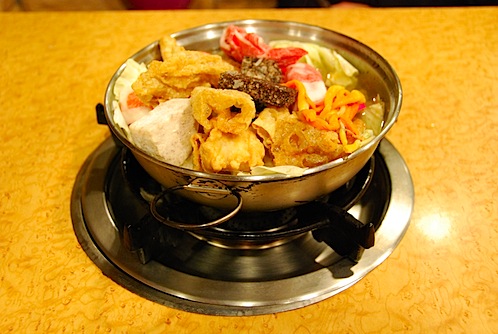
Taiwanese LOVE their hot pot! I counted five hot-pot restaurants within a 2-block radius of our apartment alone. Hot pot restaurants usually have tables with burners built right into them. You choose whatever thinly-sliced meat you want (you can even choose bacon!) and it is brought to your table raw, along with some frozen veggies. The hot-pot pictured above contains of wild boar meat—a specialty in the central-Taipei region of Alishan. Growing up, we just filled our hot pot with plain water, but all the hot-pot restaurants here fill the pot with soup stock. You drop your meat and veggies into the boiling liquid in order to cook it, and then you fish it out into another, smaller bowl filled with sauce.
In my family, hot-pot nights always begin with the whole sauce-making ritual: dozens of jars of strange and stinky pastes and sauces were laid out on the table…you add a small smidge of whatever looks/smells good into your bowl, and crack a raw egg into it before scrambling the egg/sauce mixture. When you fish your meat and/or goodies out of the hot pot, you transfer them into the raw egg concoction, and eat it up. The raw egg thing might scare some people, but I promise you, it is really delicious.
****************
This is just a small sample of the stuff we’re in eating in while we’re in Taiwan, and I bet most people in Taipei wouldn’t even think to mention these dishes since they are so common (in fact, I bet my parents are thinking, “THIS is the type of food you find special?!?”). But to me, these dishes are special; with each bite I think of my Nai Nai (paternal grandma) lovingly rolling out the dough for jiao zi, my Po Po (maternal grandma) force-feeding me more za jiang mian despite protests that I was already full, or family dinners ending with that tomato soup. So while most of this stuff tastes like my childhood, it also tastes like family, and that’s the best flavor when you’re so far away from home.

